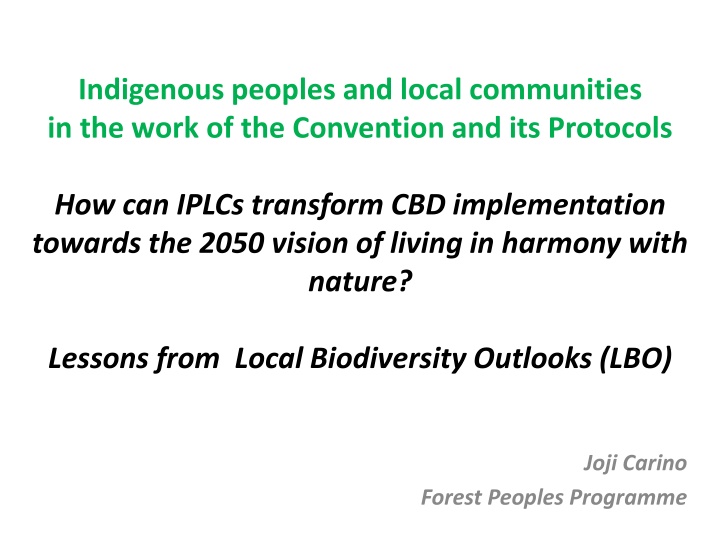IPLCs' Contributions to Sustainable Development Goals and CBD Implementation
Indigenous Peoples and Local Communities (IPLCs) play a crucial role in advancing biodiversity targets, traditional knowledge utilization, and human rights within the CBD framework. By partnering with IPLCs, transformative actions can support the 2050 vision of living in harmony with nature. Through initiatives like Local Biodiversity Outlooks (LBO), IPLCs are driving policy commitments, community-based monitoring, and sustainable practices that align with the Sustainable Development Goals. Recognizing IPLCs as essential partners fosters resilience to social, environmental, and climate changes, emphasizing the need for inclusive partnerships, human rights protection, and evidence-based monitoring for holistic biodiversity conservation.
Download Presentation

Please find below an Image/Link to download the presentation.
The content on the website is provided AS IS for your information and personal use only. It may not be sold, licensed, or shared on other websites without obtaining consent from the author.If you encounter any issues during the download, it is possible that the publisher has removed the file from their server.
You are allowed to download the files provided on this website for personal or commercial use, subject to the condition that they are used lawfully. All files are the property of their respective owners.
The content on the website is provided AS IS for your information and personal use only. It may not be sold, licensed, or shared on other websites without obtaining consent from the author.
E N D
Presentation Transcript
Indigenous peoples and local communities in the work of the Convention and its Protocols How can IPLCs transform CBD implementation towards the 2050 vision of living in harmony with nature? Lessons from Local Biodiversity Outlooks (LBO) Joji Carino Forest Peoples Programme
Key Findings from LBO Collective actions of indigenous peoples and local communities (IPLCs) are advancing the Strategic Plan for Biodiversity and all 20 Aichi Biodiversity Targets Traditional knowledge is cross-cutting and enabling of all targets IPLCs lands hold much of the world s biodiversity; supporting their actions can be one of the most effective ways to secure biodiversity conservation, sustainable use and sharing of benefits Indigenous Peoples and Local Communities and are permanent partners of the Convention Biological diversity and cultural diversity together increase resilience to social, environmental and climate changes. Mainstreaming across global change agenda and society
Key Findings from LBO Policy commitments on traditional knowledge and customary sustainable use must be translated into programmes and projects in partnerships with IPLCs. Importance of Partnerships from policy to implementation Recognising customary land tenure and traditional occupations, and protecting human rights secure social wellbeing and ecosystem and climate benefits. Measures are needed to counter the rise in assassinations of environmental and human rights defenders. Consistency with international human rights obligations and UNDRIP Community-based mapping and monitoring complement wider data and reporting systems and promote accountability for social, biodiversity, development and climate commitments. Evidence base and monitoring through Local Biodiversity Outlooks
What are the contributions of IPLCs to the achievement of the Sustainable Development Goals? 92% of SDG Targets are directly linked to human rights and require monitoring based on disaggregated data on status of those being left behind Indigenous Peoples are undertaking community-based monitoring of implementation of UNDRIP, CBD Strategic Plan, SDGs and Paris CC commitments Tools Indigenous Navigator Community information systems websites, databases Ensure monitoring of SDG indicator on secure customary and collective land tenure of indigenous peoples and the practice of traditional occupations as a cross-cutting elements under Goal 1- Ending Poverty; Goal 2 Ending Hunger and Goal 5 Gender Equality and Empowerment of Women and Girls
Virtuous Circles: Post-2020 Biodiversity Framework and Implementation Harmonisation of Global Commitments National and Local Implementation Cultural and Biological Diversity Inter-linkages Diverse Values, Institutions and Levels of Governance MAINSTREAMING NATURE-BASED AND CULTURE-BASED SOLUTIONS CBD PERMANENT BODY Diverse Knowledge Systems Traditional Knowledge, Innovations and Practices MULTI LEVEL LEARNING PLATFORMS: POLICY TO IMPLEMENTATION SCIENCE AND ILK






















